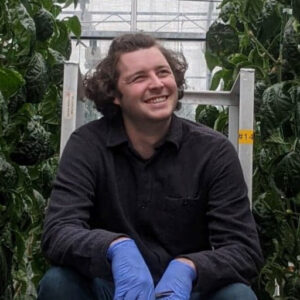2023 Schedule
Click here to read the Grower Day 2023 recap
| 8:30 – 9:00 am |
Registration |
| 9:00 – 9:15 am |
Welcoming remarks |
| 9:15 – 9:45 am |
Lighting in Greenhouse Ornamental ProductionSpeaker: David Llewellyn, Research Associate, University of Guelph.In this talk, David Llewellyn will discuss: 1) The current developments of horticultural lighting technologies to help growers in choosing lighting for their greenhouse operations; 2) How to use light (e.g., type of light, light quality, intensity and photoperiod) in greenhouse ornamental plant propagation and production based on recent research findings, especially new findings from their own research group.
|
| 9:45 – 10:15 am |
Learn about surge and lightning protection for greenhouses at Grower Day!Speaker: Ruud Roeleveld, President, R3&A Ltd.Surge and lightning protection are essential components when it comes to protecting people, preventing fire, and guarding against the failure of important networked systems. The implementation of artificial intelligence (AI), advanced lighting technology and solar-powered greenhouses are becoming critical options to develop sustainable solutions that enhance the productivity. Protection measures for modern “smart” Greenhouses are more important than ever before to secure production processes. Avoid taking unnecessary risks with the help of an efficient protection concept.
|
| 10:15 – 10:45 am |
Networking breakEnjoy a coffee, tea and treat while meeting vendors and networking with industry peers. |
| 10:45 – 11:30 am |
How AI can be used to drive meaningful ROI for your operationSpeaker: Adam Greenberg, CEO, IUNU.With new technology becoming more available and accessible to growers, it's important to evaluate how these technologies can generate a positive return on investment. This session will review computer vision, machine learning, and artificial intelligence applications for greenhouse growers in the areas of issue detection, inventory management, yield forecasting, and crop steering. |
| 11:30 – 12:00 pm |
Cultivating a Culture of Health and Safety: Greenhouse safety and the law; the business case for OHS in greenhousesSpeaker: Dean Anderson, Strategic Advisory, Agricultural Initiatives, Workplace Safety & Prevention ServicesA business that is protected can grow. That’s the essence of the business case for robust health and safety programs. Injury rates are declining but greenhouse and other agriculture workers consistently experience higher lost-time injury rates than those in many other sectors. Greenhouse operators juggle competing priorities related to labour shortages, environmental issues, and the economy. Many perceive health and safety as expensive and limiting but there is a mounting body of evidence to support the return on investment (ROI) of workplace interventions directed at improving the health and safety of workers. Through an engaging, interactive approach, this presentation from Workplace Safety & Prevention Services will:
The economic impact of a lost time injury in this sector can be significant: downtime/lost production, impact on team performance, and the challenges of recruiting specialized replacement workers. Prioritizing investments in ‘social capital’ through comprehensive health and safety programs generates positive results such as: increased productivity and organizational performance through better employee morale, fewer absences, stable production, a positive impact on reputation/brand, stronger competitive advantage and reduced WSIB premiums. The presentation will explore and build on these themes. |
| 12:00 – 1:30 pm |
Lunch Networking BreakEnjoy a full hot lunch while networking with exhibitors and peers. |
| 1:30 – 2:00 pm |
Carbon Dioxide (CO2) Enrichment in Controlled Environment Agriculture – Is it always a good idea?Speaker: Dr. Fadi Al-Daoud, Greenhouse Vegetable Specialist at Ontario Ministry of Agriculture, Food and Rural Affairs (OMAFRA).When exposed to light, plants grow by converting carbon dioxide (CO2) and water into sugar and oxygen; this is a simple way to view photosynthesis. If CO2 is required for photosynthesis, and CO2 levels are increased, so too should the rate of photosynthesis, plant growth and food production. But is it possible to have too much of a good thing when it comes to CO2 and its effect on plants? And how do plants respond to CO2 enrichment under different environmental conditions? This presentation aims to answer these questions by providing the latest scientific data on the effect of CO2 enrichment on plant growth and physiology, and its interaction with temperature, heat, and nutrition.
|
| 2:00 – 2:30 pm |
Sterile Insect Technique (SIT) for greenhouse IPMSpeaker: Jacob BassoThe sterile insect technique is an alternative pest management tool that has been successfully applied against insect pests of agriculture and human health across the world. While the technique has traditionally been used in an outdoor agriculture over large management areas, applying the SIT in greenhouses has begun to receive attention in recent years. This presentation will explain how the sterile insect technique can included in IPM programs to manage whole populations of insect pests and how it could be effectively applied in a greenhouse setting, as well as present recent research on the development of an SIT system for the pepper weevil, an important pest of both field and greenhouse peppers in North America.
|
| 2:30 – 3:00 pm |
Networking breakEnjoy a coffee, tea and treat while meeting vendors and networking with industry peers. |
| 3:00 – 3:30 pm |
Novel media amendments: How well can they reduce fertilizer use?Speaker: Christine George, Research Lead, Research & Innovation, Horticultural & Environmental Sciences Innovation Centre.The presentation will summarize NC HESIC’s recent projects, which studied potential fertilizer reduction through the use of various media amendments, all of which are produced in Southern Ontario. Reducing the use of fertilizer usage should be of concern to all growers, particularly with the rising costs of fertilizers around the world. Christine will discuss proven innovative ways in which we, as growers, can reduce fertilizer usage without compromising crop yield. Christine George |
| 3:30 – 4:00 pm |
Is there a role for biostimulants in floriculture?Speaker: Rose Buitenhuis, Vineland Research and Innovation CentreThere is a lot of interest in the use of biostimulants to enhance plant growth, nutrient uptake and stress tolerance. Unfortunately, we have very little information of how these products work and under what conditions they have a positive, neutral or even negative effect on plants. In this presentation, we will discuss experiments we did to test biostimulants in greenhouse tomato and chrysanthemum to see if they could compensate for decreased fertilizer levels, induce resistance against pests and/or protect against root diseases. Overall, we saw that results were crop- and even variety-specific. Metabolomic analysis of plant samples helped us determine which processes were activated inside the plants to try and explain the results. Overall, we confirmed that it is possible to obtain good results with biostimulants but that results should not be generalized in assuming that it will work in all crops and production systems. |
| 4:00pm |
Awards presentation and closingCelebrate the winners of this year’s Grower of the Year and Top 4 Under 40 awards.Thank you to Paul Boers and Prins for their support of the Top 4 Under 40 programs. |




